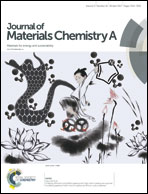Enabling effective polysulfide trapping and high sulfur loading via a pyrrole modified graphene foam host for advanced lithium–sulfur batteries†
Abstract
Traditional Li-ion batteries are facing problems due to the intrinsic limitation of their low energy density. As one type of promising Li battery, lithium–sulfur (Li–S) batteries have an advantage of high theoretical energy density (2600 W h kg−1). Nevertheless, the notorious polysulfide shuttle and low sulfur loading are the main obstacles to widespread practical utilization of Li–S batteries. To tackle these issues, we design and construct a pyrrole modified graphene aerogel foam (Py-GF) by a simple hydrothermal and freeze drying method as the sulfur host, where pyrrole provides strong chemical bonding for polysulfide anchoring and graphene aerogel foam serves as a matrix to enhance the conductivity as well as increase the sulfur loading of the cathode simultaneously. The Py-GF@S cathode, with a high sulfur loading of about 6.2 mg cm−2, displays an improved initial specific capacity (1220 mA h g−1 at 0.2C and 985.8 mA h g−1 at 0.5C) and cycle stability (capacity retention of 81% after 100 cycles at 0.5C). We anticipate that the work described here will be helpful to develop Li–S batteries that meet the requirements of practical applications.



 Please wait while we load your content...
Please wait while we load your content...